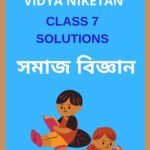SEBA Class 7 Social Science MCQ Chapter 2 Interior of the Earth Solutions in English Medium, Class 7 Social Science Multiple Choice Question Answer in English to each chapter is provided in the list so that you can easily browse throughout different chapters SEBA Class 7 Social Science MCQ Chapter 2 Interior of the Earth Notes and select need one.
SEBA Class 7 Social Science MCQ Chapter 2 Interior of the Earth
Also, you can read the SCERT book online in these sections Class 7 Social Science Objective Type Solutions by Expert Teachers as per SCERT (CBSE) Book guidelines. These solutions are part of SCERT All Subject Solutions. Here we have given Assam SEBA Class 7 Social Science Multiple Choice Notes for All Subject, You can practice these here.
Interior of the Earth
Chapter – 2
GEOGRAPHY
| MCQ |
1. What is the average thickness of the Earth’s crust?
(A) 5 km.
(B) 20 km.
(C) 50 km.
(D) 100 km.
Answer: (B) 20 km.
2. Which type of rock primarily makes up the oceanic crust?
(A) Granite.
(B) Basalt.
(C) Limestone.
(D) Sandstone.
Answer: (B) Basalt.
3. What is the layer below the Earth’s crust called?
(A) Outer Core.
(B) Inner Core.
(C) Mantle.
(D) Lithosphere.
Answer: (C) Mantle.
4. How thick is the mantle approximately?
(A) 2900 km.
(B) 1000 km.
(C) 500 km.
(D) 700 km.
Answer: (A) 2900 km.
5. What elements are mainly found in the Earth’s mantle?
(A) Silicon and Aluminium.
(B) Silicon and Magnesium.
(C) Iron and Nickel.
(D) Oxygen and Hydrogen.
Answer: (B) Silicon and Magnesium.
6. What is the core primarily made of?
(A) Iron and Nickel.
(B) Silicon and Aluminium.
(C) Basalt and Granite.
(D) Calcium and Sodium.
Answer: (A) Iron and Nickel.
7. What is the approximate thickness of the outer core?
(A) 1000 km.
(B) 2250 km.
(C) 500 km.
(D) 1228 km.
Answer: (B) 2250 km.
8. What causes the movement of molten materials in the mantle?
(A) Earth’s rotation.
(B) High temperature and pressure.
(C) Magnetic field.
(D) Ocean currents.
Answer: (B) High temperature and pressure.
9. What is the discontinuity between the crust and the mantle called?
(A) Mohorovičić Discontinuity.
(B) Gutenberg Discontinuity.
(C) Conrad Discontinuity.
(D) Lehmann Discontinuity.
Answer: (A) Mohorovičić Discontinuity.
10. What are rocks?
(A) Solid masses of minerals.
(B) Liquids found on the Earth’s surface.
(C) Gaseous materials in the atmosphere.
(D) None of the above.
Answer: (A) Solid masses of minerals.
11. Which of the following is an example of an igneous rock?
(A) Limestone.
(B) Basalt.
(C) Shale.
(D) Sandstone.
Answer: (B) Basalt.
12. How are igneous rocks formed?
(A) By the deposition of sediments.
(B) By the cooling and solidification of magma.
(C) By the metamorphism of existing rocks.
(D) By the evaporation of water.
Answer: (B) By the cooling and solidification of magma.
13. What are sedimentary rocks primarily composed of?
(A) Magma.
(B) Sediments.
(C) Lava.
(D) Minerals only.
Answer: (B) Sediments.
14. Which process leads to the formation of sedimentary rocks?
(A) Erosion and deposition.
(B) Melting and solidification.
(C) High temperature and pressure.
(D) Evaporation and condensation.
Answer: (A) Erosion and deposition.

Hi! my Name is Parimal Roy. I have completed my Bachelor’s degree in Philosophy (B.A.) from Silapathar General College. Currently, I am working as an HR Manager at Dev Library. It is a website that provides study materials for students from Class 3 to 12, including SCERT and NCERT notes. It also offers resources for BA, B.Com, B.Sc, and Computer Science, along with postgraduate notes. Besides study materials, the website has novels, eBooks, health and finance articles, biographies, quotes, and more.




